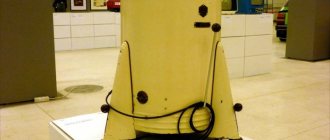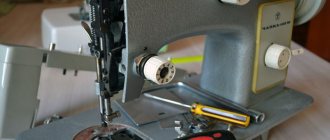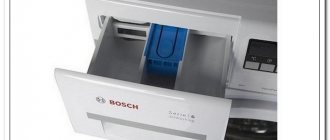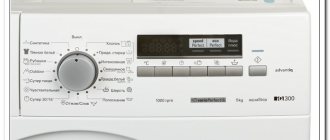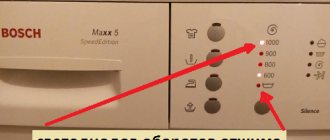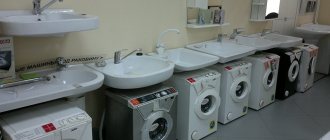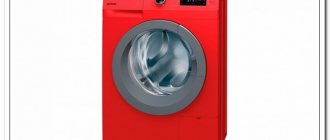Every family uses a washing machine to make the housewife's work easier. In the modern world, these are already fully automatic household appliances that can work according to a given program with various types of fabrics, maintaining a given temperature and squeezing almost dry. In Soviet times there were no such washing machines. One of the most common brands was washing machines produced by the Riga Electrical Machine Building Plant. Let's look at them in more detail.
Riga 54
At one time it was possible to wash clothes with a dry weight of 2.5 kg. The engine power demonstrated by this machine over a long period of operation was 250 watts. At peak load it could in some cases reach up to 450 watts.
Riga 54 was produced starting in 1954.
During operation, the device that mixes the water performs reciprocating movements.
The washing machine body includes two cylindrical parts:
- top,
- bottom.
The latter houses the electric motor together with the gearbox, its suspension system and a water hose.
The upper part contains a centrifuge, which during washing rotates at a speed that can reach up to 800 revolutions per minute. There is also a stirrer and a special balancing device designed to ensure that vibration during operation is minimal.
The washing cycle could last no more than 6 minutes. To operate, it was necessary to pour hot water into the tank. Draining water could only be done manually.
This model used a centrifuge. In spin mode, the water was drained into a separate reservoir. It could be poured out after finishing the wash or refilled for subsequent treatment of the laundry.
The machine casing has three legs with wheels, thanks to which the washing machine can be easily moved if the need arises.
How to use the engine
The electric motors that modern units, such as those from Indesit, are equipped with are quite reliable and durable. And even a part from an old washing machine of a brand like Vyatka can last long after the equipment itself has become hopelessly outdated.
In a washing machine, an electric motor rotates the shaft, which drives the drum. If the part is removed from the unit, a wide variety of attachments can be attached to the shaft, resulting in new tools and accessories. The most common ways to use an electric motor are:
We have listed only a small part of the devices that can be obtained from a washing machine motor. In order to make one of them, or come up with your own application, you need to know how to connect the motor so that the winding does not burn out.
Riga 55
This model was an improved version of the previous model. It was practically a copy of the Swedish Husqvarna car.
The motor operated from a network with a voltage of 127 V.
Based on the Riga 55 model, the following were also developed:
- Riga 60,
- Riga 8,
- Riga 13,
- Riga 15,
- Riga 17.
The number of cars that were produced daily was two thousand copies. In terms of annual production volume, we could talk about the production of more than 600 thousand washing machines.
Riga 60
This washer was a further improvement of the previous model. New in Riga 60 was the use of an improved spinning device. Here it was possible to adjust the distance between the rollers. In addition, compared to the previous model, they were 56 mm longer. Adjusting the distance made it possible to spin not only regular-sized laundry, but also fairly large ones.
Some characteristics of this model:
- The weight of the car was 30 kg.
- The height without the squeezing device is 734 mm, and when it is installed it is 946 mm.
- The motor power is 150 W, it could use a 220 V or 127 V network.
You can wash 2 kg of laundry in one wash. Washing usually lasted from two to four minutes. After this, rinsing was performed. It took 1 - 2 minutes.
Riga 8
This model had an important advantage over its predecessors. It was equipped with a special pump to drain dirty water after washing.
This washer used a 350 W electric motor rated at 220 V and 50 Hz. There is a version of this washing machine that is designed for 127 V mains voltage. In this model, a timer was used to turn on, designed for a washing cycle of no more than 6 minutes. After the time allotted for washing has expired, the machine turns off.
This model had an additional metal spinner for washed clothes.
However, such a model, from a modern point of view, had modest capabilities: in one washing cycle it was possible to process no more than one and a half kilograms of laundry. In this case, it is necessary to fill the machine tank with 30 liters of water.
An important advantage of the Riga 8 machine was that stainless steel was used to make the tank. This feature ensured the ability to operate the washing machine for several decades.
The height is 690 mm, and with a squeezing device - 920 mm.
Riga 13
This model was practically no different from the previous one:
- You can wash up to 1.5 kg of laundry at a time.
- Water can be filled with no more than 30 liters.
- The weight of the machine excluding packaging is 25 kg.
- The height of the machine without installing an additional device is 690 mm, with it - 920 mm.
The motor connection diagram is similar to how it was done in previous models.
It began to use a hose that pumps the soap solution flowing back from the tank. The designers who worked on this model decided that this improvement improves the washing effect.
The power of the electric motor in Riga 13 was equal to 180 W, while the number of revolutions per minute was 1425. The motor operated from a 220 V or 127 V power supply.
Connection diagrams and parameters of electric motors of VYATKA washing machines
Washing machine repair Vyatka →
Connection diagrams and parameters of electric motors of VYATKA washing machines.
Connection diagram of electric motor windings type DPC 100-2/16 TS 15 TP 12/14 FMGSE 8/90 (or DPC 100-2/16 TS 13 or DAK164-180/60)
| Motor terminals | Winding resistance, Ohm |
| 2 – 4 2 – 8 4 – 8 6 – 3 6 – 7 3 – 7 | 25,0 ± 2 25,0 ± 2 30,8 ± 2,2 8,9 ± 0,6 5,8 ± 0,4 14,7 ± 1 |
Connection diagram for electric motor windings type DPC 100-2/16g S13 TP 1/93 (DPC 100-2/16s S13)
| Motor terminals | Winding resistance, Ohm |
| 1 – 2 1 – 3 1 – 4 1 – 5 4 – 5 | 25,0 ± 1,8 8,6 ± 0,6 55,0 ± 3,9 55,0 ± 3,9 77,0 ± 5,4 |
Electric motor (M)
Asynchronous. U = 220 V, F = 50 Hz, C = 16 µF
Collector U = 220 V, F = 50 Hz
| 21 | 20584408.0 "SOLE" |
| Motor terminals | Winding resistance (Ω), Ohm, ±7% | |
| Vyatka-Maria (Katyusha) 1022 | ||
| 1–2 | Stator (Excitation Winding) | 1,77 |
| 3–4 | Armature (Armature resistance is given without taking into account brush resistance) | 1,34 |
| 5–6 | TG | 184 |
| Control type | Speed, rpm not less | Power consumption, W | Current consumption, A | Torque moment, N m |
| without EM (U=220V) | 11300 | 480 | 2,5 | 0,19 |
| with EM | 650 | 250 | 4,6 | 0,7 |
See also: Basic faults and DIY repairs of automatic washing machines
Riga 17
In this model, the tank was made of stainless steel, just like in the previous model. The bottom was not located in a horizontal plane, but at an angle. It contained an activator, which, by means of rotation, mixed the water. One of the features of this model is the presence of two washing modes:
- soft,
- hard.
They differed from each other in the direction of rotation of the activator. The first of them was used for washing clothes made from more sensitive fabrics. The hard mode was used to process clothes made from coarser fabrics.
In the first case, the activator rotated clockwise, in the second - counterclockwise. The activator ribs are arranged in a spiral.
This model had an important improvement: an induction water heater was included in the design. It was not necessary to use cold water for refueling. The hostess could pour it and then heat it using the built-in device.
The use of this improvement had its significant drawback: heating water required high power consumption. When turned on, the required power was 2 kW, and with further operation it decreased to 1.2 kW.
Soviet motorcycles for ShKMG, part 26: High tech 70s - Riga C series mopeds.
A new product in 1971 on the race tracks was the Riga 15C moped. Without exaggeration, we can say that this was a real breakthrough in Soviet motorsport. The 15C chassis was so successful that it lasted in racing for almost twenty years and served as the basis for subsequent models that worthily represented our country in international competitions.
The chassis of the moped was developed and manufactured at the Sarkanā zvaigzne , the engine was used by Serpukhovsky, VNII Motoprom, ShK - 50, almost “square” dimension 40X39.6 mm, developing 13.5 hp. Torque was transmitted through a dry clutch to a six-speed gearbox. A spool inlet is used.
Appearance Riga - 15C.
Oil pumps were installed on mopeds that were used in international competitions; on the remaining 15C models, lubrication was carried out through a gasoline oil mixture.
Engine for GP with separate lubrication system.
At Rigi-15C, our riders Eduard Borisenko and Alexander Smertin competed at the World Championships in the GDR in 1972 and took seventh and eleventh places, respectively.
Eduard Borisenko, 1972, Sachsenring GP.
Here is the data on the Riga-15C chassis. These figures will be true for all subsequent models of Riga racing mopeds, up to 21C. Dimensions: length - 1848 mm; width (along the steering wheel) - 450 mm; height (along the fairing) - 885 mm; base - 1280 mm; front fork angle - 26°; maximum roll angle left and right - 50°; frontal area - 0.286 m2; tire size: front wheel - 2.00-18, rear wheel - 2.25-18.
Riga - 15C on the highway.
During the production of the 15C, changes were made to its design. For example, four-pad, four-cam open-type front brakes appeared.
The exposed front dual brake is a piece of engineering.
Riga - 15C with a modernized front brake.
In total, about 20 Riga-15C mopeds were produced.
The next model was Riga - 17C from 1976. The main difference is the water-cooled engine. There was no pump in the design; the cooling system was built on the so-called thermosiphon principle.
Classic look of Riga - 17C, thermosiphon cooling system.
Engine power increased to 16.5 hp. at 15000 rpm. Now let's imagine an engine with a liter power of 330 hp. and this is in 1976! An amazing achievement, on par with the world's best examples. Compression ratio 13 units, fuel - a mixture of AI-98 gasoline and oil (25: 1); The ignition system is electronic non-contact.
An aluminum cylinder with a cast iron sleeve pressed into it. Experiments were carried out with an aluminum cylinder coated with Nikasil. The aluminum piston has one flat steel ring. The connecting rod bearings are needle bearings, in the upper head there is bulk or with an aluminum cage, the lower one with a steel cage. Transmission: clutch - dry, multi-disc; forward gear - chain (3.47); gearbox - six-speed (gear ratios, respectively: I - 2.220; II - G.650; III - 1.367; IV - 1.200; V - 1.095; VI - 1.045); reverse gear - chain, gear ratio - 2.467, or 2.533, or 2.600, or 2.667, or 2.733.
Riga - 17C.
The tail, tank, fairing are made of plastic. Dry weight was 62.3 kg. Maximum speed - 153 km/h; braking distance from a speed of 60 km/h - 14 m. from 100 km/h - 48 m; fuel reserve - 8 liters. Crew part: frame - tubular, spinal; front fork - telescopic, with hydraulic shock absorber; rear fork - lever, made of rectangular steel pipes; brakes - drum.
The next model is Riga - 19C from 1978. There is no exact data on how it differs from the 17C; one can only assume that the cooling system has been modernized and a water pump driven by an electric motor has been introduced into the design.
Riga engine - 19C. The oil and water pumps are visible.
Undressed Riga - 19C. The front brake is a closed type, it is not clear how it ended up here. Once again, I’ll make a reservation that the division into 17C and 19C is conditional, since it is not known exactly what the features and differences of these models are.
Riga series C on the Riga circuit, driver Edvins Labeckis.
Riga S flies along the track in a deep tilt. You have to be a desperate person to ride at 150 km/h on such a small and light moped.
Of course, racing equipment was intensively modernized both by the plant itself and by the racers within the framework of existing rules. In old photographs you can see mopeds with Siauliai engines -
Riga series C, engine V - 501M.
Another such moped, the Vairas engine head is visible. Mopeds with such two-speed motors were used in junior competitions. Of course, there were not enough such mopeds for everyone who wanted them; there were other options, for example, homemade designs.
An example of such a homemade design, parts from road mopeds were used.
The “featherbed” frame is made for the V-501 motor, appreciate the beauty of the design and the quality of workmanship. But this is a homemade moped created by enthusiasts.
An amazing fact, but the Riga-15C chassis was also used in the 125 cc class.
Motorcycle with Riga - 15C crew part and 125 cc engine.
Moreover, this was not the first such motorcycle. There is a photo in which a 125 cc engine is installed in the chassis of the Riga-11C. unknown origin - homemade or Serpukhov. Eduard Borisenko performed there.
Motorcycle with 125 cc air-cooled engine. in the running Riga - 15C.
In 1983, in the magazine “Behind the Wheel”, the head of the design bureau of sports motorcycles at the Sarkana Zvaigzne plant, V. Kleinberg, announced the release of a new model Riga - 21C. Externally, it can be distinguished from the previous model by its cast wheels. Magnesium alloy wheels were cast in Leningrad, after which they were processed at the Vihur plant in Tallinn and arrived in finished form in Riga.
Riga - 21C. Judging by the photo, the women were delighted with such a moped.
Engine power was increased to 18 hp / 13.2 kW.
Riga - 21C.
The last racing motorcycle of Sarkanā zvaigzne was the Riga-23C. Three of these motorcycles were made, one with a steel frame and two with aluminum.
Riga 23C with aluminum frame…
...and with steel.
Engine Riga - 23C.
Riga - 23C, driven by Raimonds Aizstrauts, 1984.
Ainārs Karro and Raimonds Aizstrauts, 1987.
The power of the 125 cc Riga - 23C engine was 41 hp. at 14500 rpm. Sports achievements of Riga 23C - four USSR championship titles from 1983 to 1986 and silver in 1987. At the USSR Championship we had to compete with our best racing motorcycles - Vikhur with Rotax engines. At international competitions in the fight against foreign cars, the best achievement was fourth place in 1987. The author of these achievements is one of the best racers of the USSR from Riga, Raimonds Aizstrauts.
Finally, as usual, let's see which of these mopeds have survived to this day.
Riga 17C of connoisseur and collector of Soviet racing equipment Martijn Stehouwer from the Netherlands. In great shape, still racing.
Riga - 17C from the Netherlands, currently for sale on Ebay.
Riga - 15C from Japan. It is unknown how the wind blew it there.
Riga - 17C from the collection of MOMU Mootorispordi Muuseum from Riga.
Alexander Smertev and Riga - 15C.
Kaspars Brigzne and his Riga - 15C at amateur races in Riga.
Another Kaspars Brigzne moped - Riga - 21C.
Riga - 23C Raimonds Aizstrauts. A rare shot where you can see both 23Cs with an aluminum frame. By the way, for the 2019 racing season, Raimonds plans to restore his motorcycle and take part in races, thirty years later.
Revived Riga 23C.
That's all about these amazing racing mopeds. Everyone already knows well about the sad fate of the Sarkanā zvaigzne
Raimonds Aizstrauts, Kaspars Brigzne, Tony Laan took part in the preparation of the material, thanks to them.

